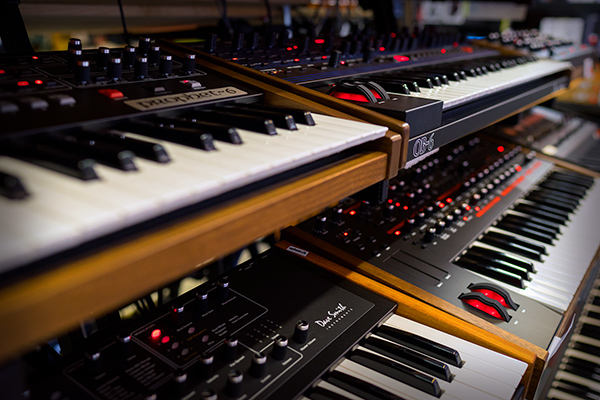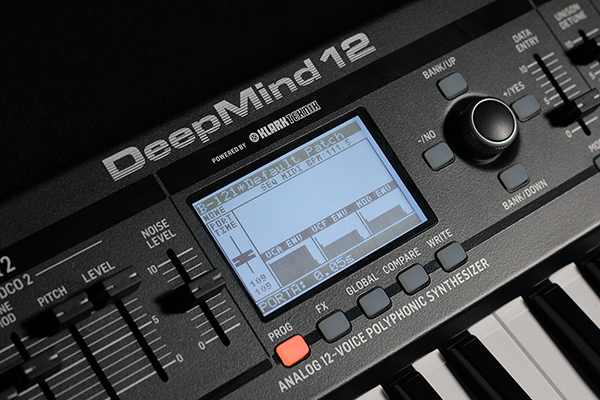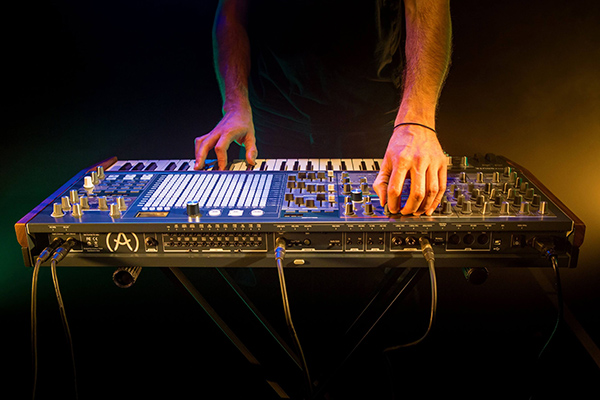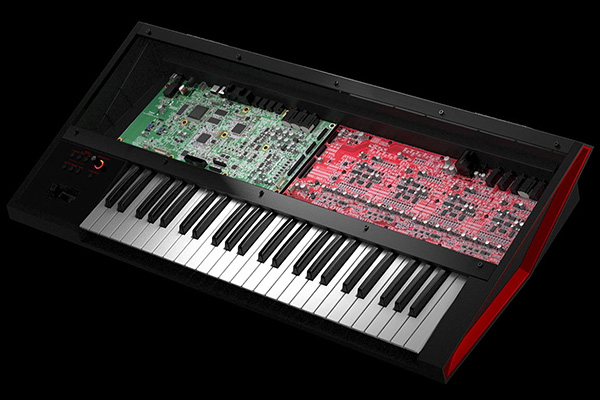 Dave Smith Instruments Pro 2 is one of those creatures which are made in order to please their author in the first place and not to hit the market. Those who have been working the hell out of them while going through the crazy market requirements and tough conditions can finally relax – no one is surprised or attracted by the numbers, the musicians have already acquired their favorite working tool and now they tend to feel they might be lacking some romance in the demanding music production process. Dave Smith has earned his right to define “romance” the way he sees it so he’s devised a monophonic synthesizer with analog filters and amplifiers comprising a mighty sequencer.
Dave Smith Instruments Pro 2 is one of those creatures which are made in order to please their author in the first place and not to hit the market. Those who have been working the hell out of them while going through the crazy market requirements and tough conditions can finally relax – no one is surprised or attracted by the numbers, the musicians have already acquired their favorite working tool and now they tend to feel they might be lacking some romance in the demanding music production process. Dave Smith has earned his right to define “romance” the way he sees it so he’s devised a monophonic synthesizer with analog filters and amplifiers comprising a mighty sequencer.
Like Prophet 12, Pro 2 is based on 4 digital oscillators and built on the components of the DSI leading synthesizer though it’s definitely not just a Prophet 12 spin off. Besides the standard waveforms there are 12 digital ones (changing the parameters of the waves the way it’s implemented in wavetable synthesis), 3 noise types and the possibility to shape superwaves which can detune the sound.
Pro 2 enriches its monotimbrality with unusual tricks: it allows assigning different octaves and waveforms to each of its four oscillators triggering a different oscillator with each note in a riff. The effect strengthens in paraphonic mode owing to the individual envelopes per each oscillator. All this promotes Pro 2 as a most convincing pretender to the polyphonic synthesizer throne among any other similar instrument. Until a signal approaches the filters it goes through the “Character” section the processing stage of which includes such algorithms as Bit-crushing, Drive, Girth and Air. And even here we should pay attention to the fact that the engineers eschewed the classic signal path circuitry – when generated signals go straight to filters and their envelopes and after - pass through the amplifier section. By the way, these processing algorithms alter the sound in such an amusing manner that it made Dave Smith think about creating and releasing them as separate modules in the Eurorack format.
The routing possibilities of the analog filters – one of which is based on the low pass filter of Prophet~6 and the other one is state variable (replicates the SVF, State Variable Filter of Oberheim SEM; it was also featured in OB-6) – might seem one of the most intricate, flexible and versatile among the filters of similar synthesizers. The modulation allows exploring the wide range of sources and destinations: 4 LFOs, 2 additional envelope generators with a delay stage (D-ADSR) dedicated to filters and amplifiers, 4 CV inputs routing any modulation source into the matrix and thereby extending considerably the possibilities of the synthesizer and of the group of the instruments which interact through CV signals. We should definitely note such effects as distortion, 3 digital delays + old school analog emulation and a tuned feedback effect: feedback sends the VCA analog output though a tuned delay, and after the output is sent back to the oscillators in order to be processed by “Character” effects. Controls include feedback amount and tuning.
 We’ve done with the lyrics - let’s get down to the prose. Behringer and its DeepMind 12 which is presented in teeny dozes (making us tired of waiting not for the unit but even for the information itself) put us back down to earth urging to get real. Here we observe a completely different approach – while Dave Smith sculpted his sophisticated artwork following own ideas, Uli smashed our minds with analog. A 12-note polyphony, 24 oscillators (2 DCOs per voice and 2 LFOs with 7 waveforms), matchless overall number of components (4000!) – there are no synths on the market which could beat this. The instrument offers a full set of functions – envelope generators (for filters, amplifiers, modulation), 4-channel effects processor providing 30 digital processing algorithms, analog amplifiers as well as arpeggiator and sequencer. The effects have a flexible parameter editing and can be put and applied in any order.
We’ve done with the lyrics - let’s get down to the prose. Behringer and its DeepMind 12 which is presented in teeny dozes (making us tired of waiting not for the unit but even for the information itself) put us back down to earth urging to get real. Here we observe a completely different approach – while Dave Smith sculpted his sophisticated artwork following own ideas, Uli smashed our minds with analog. A 12-note polyphony, 24 oscillators (2 DCOs per voice and 2 LFOs with 7 waveforms), matchless overall number of components (4000!) – there are no synths on the market which could beat this. The instrument offers a full set of functions – envelope generators (for filters, amplifiers, modulation), 4-channel effects processor providing 30 digital processing algorithms, analog amplifiers as well as arpeggiator and sequencer. The effects have a flexible parameter editing and can be put and applied in any order.
Despite the innovative structure even offering built-in Wi-Fi, Behringer DeepMind 12 looks is classic enough – metal casing, wooden side panels, a 4-octave keyboard with aftertouch; the control elements – sliders and encoders - are arranged into blocks/modules; there’s also a monochrome though big display. All we have to do now is to wait till DeepMind 12 finally appears on the shelves and see whether there are any hidden flaws, peculiarities or simply surprises which are obscured by the tempting $1000 price. The release date which was announced to hit August, 2016 is still officially unconfirmed.
 Arturia let us know about MatrixBrute in 2016 quickly becoming another eccentric fancy of the French. A 100% analog monophonic synthesizer with an incredible modulation matrix – well, now it’s credible but still mesmerizing. 3 classic oscillators taken from Microbrute/ Minibrute line + 1 sub oscillator, 2/4-pole filters, 3 envelope generators, 49 full size keys with aftertouch encased in a Minimoog Voyager XL-like housing of super quality.
Arturia let us know about MatrixBrute in 2016 quickly becoming another eccentric fancy of the French. A 100% analog monophonic synthesizer with an incredible modulation matrix – well, now it’s credible but still mesmerizing. 3 classic oscillators taken from Microbrute/ Minibrute line + 1 sub oscillator, 2/4-pole filters, 3 envelope generators, 49 full size keys with aftertouch encased in a Minimoog Voyager XL-like housing of super quality.
The idea of modulation matrix was all about the replacing puzzling and confusing (annoying for someone) patch cords – now we see a platform “paved” with knobs and featuring a tactile matrix. When in MOD mode any of the 16 modulation sources can be routed into any of the 18 modulation destinations allowing you to follow every manipulation on the display. The matrix helps to create sequencer patterns and can also be used in a Preset mode. Besides such a total control featured by the ridiculously huge panel there is an impressive connectivity offered: 12 CV in/out, audio in, gate in/out, sync in/out, MIDI in/out/thru, USB in/out, 2 pedals (expression + sustain) and stereo outputs occupy the panel as densely as knobs and buttons plant themselves within the control forefront.
The synthesizer includes a ladder filter and Steiner-Parker filter, 5 chains of analog effects. The developers of MatrixBrute reveal their concept saying that the idea was to combine the flexibility of a modular synthesizer with the intuitive and comprehensible interface – “one knob per function”.
 Roland JD-Xa found its own way to play with analog structure despite the words of doubt we heard Roland managers say about analog synthesizers. Actually Roland didn’t change their mind on the fact that pure analog is outdated because JD-Xa comprises 2 sound generating sections while many specialists emphasize that the digital part prevails over the analog one. The analog synthesizer (2 oscillators per voice) features 4 parts each of which is capable of functioning independently as a 2-oscillator monosynth or you can use a Polystack function and turn any of these parts into a 4-note polyphonic analog synthesizer. In mono mode you can stack all the 8 oscillators of the 4 parts with 2 waveforms and individual settings per each. The analog oscillator produces a nice enwrapping sound which is molded by the high quality filters: gloomy LPF1 and bright LPF2 – 4-pole, LPF3 (+ BPF and HPF) – 2-pole. An additional HPF will remove the extra hum of the low frequencies if necessary. The output of each part features an equalizer.
Roland JD-Xa found its own way to play with analog structure despite the words of doubt we heard Roland managers say about analog synthesizers. Actually Roland didn’t change their mind on the fact that pure analog is outdated because JD-Xa comprises 2 sound generating sections while many specialists emphasize that the digital part prevails over the analog one. The analog synthesizer (2 oscillators per voice) features 4 parts each of which is capable of functioning independently as a 2-oscillator monosynth or you can use a Polystack function and turn any of these parts into a 4-note polyphonic analog synthesizer. In mono mode you can stack all the 8 oscillators of the 4 parts with 2 waveforms and individual settings per each. The analog oscillator produces a nice enwrapping sound which is molded by the high quality filters: gloomy LPF1 and bright LPF2 – 4-pole, LPF3 (+ BPF and HPF) – 2-pole. An additional HPF will remove the extra hum of the low frequencies if necessary. The output of each part features an equalizer.
The digital section of JD-Xa incorporates 4 parts totaling 64 voices. There are three oscillators, noise sources and 14 digital filter types available for each part. The concept of JD-Xa becomes clear when you explore the depths of its attractive sounds which result from layering its digital waveforms upon one or several analog parts: manipulating them you can achieve really amusing combinations by mixing up to 12 (out of 450 possible) PCM-waveforms and the analog section. You will also have fun experimenting with the sound by putting the noise, microphone signal or any of the digital parts through analog filters with the help of Aux section. The versatility offered by JD-Xa hybrid makes it a market chameleon (or a nine-life cat) – unlike a classic analog synthesizer which has a one-cycle life span and the release is firmly followed by a “discontinued” status while a hybrid synthesizer allows software updating as long as it makes sense so that you won’t need anything else.
The new analog market attack has nothing to do with stepping back or deliberate simplification, or retro tendencies. These ones are completely new instruments and though there are enough of synthesizers featuring absolutely different architecture it seems that the creative potential is inexhaustible. We bet there are going to be more hybrids soon.
